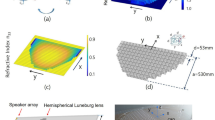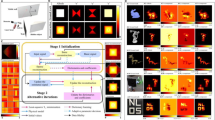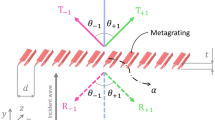Abstract
OBJECT ranging can be achieved by humans using the sound reflected or scattered from obstacles. For a range of wave-lengths short compared with the size of its surfaces, and long compared with the size of the irregularities in these surfaces, specular reflexion will be obtained and an acoustic image of the sound source will be formed analogous to an optical image. In many situations, however, such as the approach of an external corner, an acoustic image may not be audible from the observer's position. In these cases sound scattered from the edges and irregularities may, or frequently may not, give the necessary warning. Such signals are, however, weak compared with those of the acoustic image with which we are chiefly concerned.
This is a preview of subscription content, access via your institution
Access options
Subscribe to this journal
Receive 51 print issues and online access
$199.00 per year
only $3.90 per issue
Buy this article
- Purchase on SpringerLink
- Instant access to full article PDF
Prices may be subject to local taxes which are calculated during checkout
Similar content being viewed by others
References
Wood, A., Acoustics, 200 (Blackie, London, 1940).
Cotzin, M., and Dallenbach, K. M., Amer. J. Psychol., 63, 485 (1950).
Bassett, I. G., and Eastwood, E. J., J. Acoustical Soc. Amer., 36, 911 (1964).
Supa, M., Cotzin, M., and Dallenbach, K. M., Amer. J. Psychol., 57, 133 (1944).
Leonard, J. A., and Carpenter, A., Amer. Found. Blind Bull., 4, 70 (1964).
Leonard, J. A., and Wycherley, R., (personal communication).
Whitfield, I. C., and Evans, E. F., J. Neurophysiol., 28, 655 (1965).
Author information
Authors and Affiliations
Rights and permissions
About this article
Cite this article
WILSON, J. Obstacle Detection using Ambient or Self-generated Noise. Nature 211, 218 (1966). https://doi.org/10.1038/211218a0
Issue date:
DOI: https://doi.org/10.1038/211218a0



